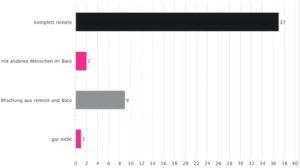Some still call it teleworking. To work from somewhere other than the dedicated office. Although it is not new as a concept, remote work has taken on completely new dimensions in the current exceptional situation of the coronavirus. Home offices, often viewed with great skepticism, have long been a reality and are perhaps one of the most popular manifestations of the modern working world.
Many companies allow their employees to work remotely for one or more days. Some manage entire teams completely remotely, without shared offices or in-person presence. Remote work is a trend of globalization, especially popular in IT-heavy environments. As a result, many experiences have been made, but there are also many open questions. Time for a review!
Remote work – a sudden megatrend
A meetup on remote work was planned long before Corona. However, the current situation pushed us out of our well-known in-person presence and into the virtual world – in line with the idea of mobile collaboration, the 30th NEW WORK BERLIN Meetup took place as a virtual/remote meeting for the first time. Together with the invited experts Manuel Pistner, Elizaveta Brisker and Jonas Spengler, we discussed the concept of remote working, cultural change, opportunities and challenges.

Over half of our participants currently work exclusively remotely
The learning curve is currently very steep: Suddenly we all live and work in a new, different, physically distant world. How quickly everything has changed: apart from a few growth pains, remote working has become a mega-trend, not least because of the Corona pandemic. Because it can also work despite all the prophecies of doom. We are all gaining new experiences in a very short time, organizing video conferences, utilizing new communication tools or simply using the existing ones differently, more efficiently and effectively. We learn on the way. With great flexibility and, at best, great tolerance for error. And now, after a few weeks of remote working, there is great interest in an exchange on this topic. Two-thirds of the approximately 60 participants in the meetup are currently working fully remotely. A smaller proportion of them in a mixture of office and remote.
Breaking new ground – The story of a digital agency
Manuel Pistner, CEO of Bright Solutions GmbH, joined us in the meetup from Montabaur and shared his experiences about setting up a remote working structure in his own company. In 2018, Manuel employed 45 experts in a rather hierarchical and conventional structure. As the company grew, projects became more and more elaborate and complex while his own time became increasingly scarce. To counter this, he built up a second management level, trained project managers and expanded the organizational structures. However, this was not enough anymore: customers wanted to be supported faster and more spontaneously, the question of quality and flexibility grew. Manuel found that his rather classic hierarchical management concept no longer suited the challenges of a modern consulting firm.
Balancing between the expectations of his clients and his employees, it seemed impossible to him to always have the necessary employees and competencies available. Above all, because demand was simply too fluctuating and sometimes at very short notice.
For this reason, Manuel tested various ideas, all of which didn’t really work:
- Cooperation with local partner companies: They have the same shortage of skilled workers and specialists.
- Use of offshore/nearshoring partners: Here he completely lost transparency and had no control over specific project staff, but rather had to deal with account managers. More about this in Manuel’s TEDx Talk.
- Withdrawal to 100% technological specialization: His customers did not really want this.
- Local freelancers: There are simply too few of them. If he found any, they were fully booked and wanted long-term projects with a duration of 3 months or more. So they were not available for short-term immediate support.
- His own training of local specialists also failed due to the lack of suitable applicants.
Solution-oriented work with distributed experts
Manuel ultimately found his solution in cooperation with experts who, although distributed around the world, were available at short notice and could be deployed quickly. Their key competence is solution-oriented work. In the beginning, according to Manuel, he set off for a week to get to know people personally, familiarize himself with their working methods, assess their competence, and discuss his ideas with them. The goal: to build mutual trust as a basis for cooperation. Of course, there were also some concerns at the beginning, among other things about data security and reliability. In the course of time, he learned to trust his experience and gut feeling more and more.
With the expansion of his team to form a global expert base, new challenges came along, for example: How can collaborations and projects be managed sensibly? Manuel’s answer was to reverse the hierarchical organization of the company – now the experts organize the projects themselves instead of being planned hierarchically from the top (and far too often by Manuel himself). The basic idea is to lead by results, not by being present. He experiences this as a new inner attitude, because for his work and the projects it becomes more and more irrelevant how and what exactly the employees do, as long as it works and the results are right. Instead of hierarchical levels of control, he believes it is important to consistently orientate himself towards modern control instruments such as OKRs (Objectives and Key Results) and to be supported by professional coaches. They help to ask the right questions in order to achieve goals. This enables him to lead on the basis of facts and thus to lead by results.
New standards for communication and cooperation
The new approach also helps with conflict and communication skills. A coach is always available and actual existing conflicts are moderated. In the office, we do not resolve a conflict with whistles but with communication. In order to establish personal connections with employees from different corners of the world, virtual video meetings are used to see each other and enjoy a drink together.
Manuel tries to dictate as little as possible. Nevertheless, there is one very elementary rule he has introduced to his remote workers: every decision must be fair – for the team and economically. This was especially relevant in the context of the introduction of transparent salaries.
Almost as a side effect, but as a big advantage of remote working, Manuel observes a completely different point: nobody can suddenly stand behind you and ask questions:
Excuse me, can you quickly tell me how…?
By eliminating this classic and sometimes fatal interruption, which everyone knows from everyday office life, employees remain undisturbed in their workflow and thus more focused. The communication between colleagues can be controlled by each individual using notification settings. Also, the self-competence is strengthened enormously. With the right attitude, self-learning in remote working is even made easier. Manuel’s company generates small videos and tutorials for this purpose: as soon as a more complex problem arises and another expert can solve it, it is recorded and made accessible. In times of knowledge work it is a well-known goal of companies to make implicit knowledge explicit.
Pitfalls and strengths
After Manuel’s insights, Elizaveta Brisker and Jonas Spengler continued to discuss open questions about remote working. Elizaveta (Liz) was People Operations Partner at the IT startup Travis CI (CI=continuous integration) for more than 4 years. The company had 25 employees at its headquarters in Berlin and 45 remote employees, which were spread all over the world. Jonas is Co-Founder and CTO at komoot GmbH, the largest platform for outdoor activities. Komoot has been completely remote since its foundation, currently working with about 60 permanent employees and 30 freelancers, who are spread over 12 European countries.
Location-independent collaboration is automatically accompanied by digital communication. It goes without saying that challenges arise, for example in recruiting. Many tools support the process very effectively. The most meaningful elements of an application process, such as the structured interview or work samples, can be easily carried out via Zoom, Skype, Hangouts, and the like. However, when getting to know each other virtually, sometimes something falls by the wayside.
It is difficult to really understand the personality of the other person as you would in a face-to-face meeting.
This is how Liz describes a relevant disadvantage in the recruiting process.
Also an unfavorable camera position or bad internet connection can play a role here and distort the impression. Jonas observes that in the face-to-face interview, attention is paid to other things that actually have no relevance at all in the assessment of the qualification. In a virtual job interview you don’t realize how tall a person is. This may lead to a surprise in the actual real meeting.
Similar to Manuel’s experience, recruiting is simply necessary for the desired growth. His experience was positive from the very beginning. Many applications were received from people who were interested in the topics and company. So there is little sign of a shortage of skilled workers. There are also reasons for working remotely on the part of the employees. Some people prefer to turn their backs on the big urban corporate world and live in the country. From Jonas’ point of view, the pool of applicants for remote working is simply larger compared to komoot limiting itself to permanent office jobs.
How does onboarding work?
Jonas has made good experiences in bringing all newcomers together for 1-2 weeks and training them. Since the whole komoot team meets three times a year, especially for strategy development, he ideally combines such meetings with the onboarding of new employees. Then there are also many outdoor activities such as joint bike tours – not surprising for an outdoor platform. In order to build trust and establish good communication, komoot has now developed a remote onboarding process. It consists of unstructured meetings, where all newcomers meet virtually and also have a beer together from time to time. This is where the exchange takes place without a strict agenda. In this way, the employees get to know each other outside of business meetings and without their business face.
Liz does onboarding rather face-2-face, where new employees are sent to their co-workers. But this is complemented, for example, by a chat lottery, where 1on1s with non-work related topics such as computer games or books are randomly distributed. Trust does not only come from the employer but also has to be accepted by the employee, by sharing problems and complaints as well as positive aspects of the work. Liz has had a good experience with the use of Github Issues. This increases transparency in remote onboarding by making the status of onboarding visible to everyone.
Opportunities and challenges of human resources development
The greatest opportunity of remote working is clearly the increased flexibility. This can be seen, among other things, in in-house training through sparring partners or peers who can work together across a location or departmental boundaries. After all, bringing good employees together is easier if it is independent of location. Even appraisal interviews can easily be conducted remotely, according to Jonas’ positive experience. However, celebrating success is difficult – Liz and Jonas agree on that. Sitting in front of a screen is not comparable to the personal energy that fills a room when everyone is really together in one place. It is therefore important to find a good balance between personal and remote meetings. At komoot this is complemented by the all-hands meetings, which Jonas calls supercharged gatherings, in which everyone comes together and people connect extremely well.
Resource management in remote environments
When your experts are working remotely, setting up project teams can be a real pain. Modern organizations often pitch new projects to their employees and enable them to apply to open project roles. This might be easy when you have regular on-site meetings. But in a distributed setting, it becomes difficult to check in with everybody when a client request flies in. Thus, it is an even bigger challenge to identify skilled and available employees that match client needs. Workforce management solutions like iCombine streamline this process by promoting transparency throughout the project planning process and by matching people to projects or training – and vice versa. Thus, remote teams can be set up very quickly to meet the momentum of the market. If human-centric planning is important to your organization, get in touch with our co-host Richard.
Remote hacks for better virtual meetings
Liz and Jonas gave us recommendations on how to conduct virtual meetings efficiently. Of course, we do not want to keep these from you:
- Act like you were in the Office! We often start in remote mode quickly and efficiently. But the moment of arrival falls by the wayside and we only talk when we are asked. However, a relaxed check-in is important to build up a relationship. Reserve time for the virtual coffee chat!
- How do you do? Check-in and build trust by asking questions like: What happened in your life today/last week? What made you feel uncomfortable? The important thing is to recognize what the other person needs. It’s about welcoming everyone in a different way. Listening, participating, withdrawing … giving everyone the chance to express themselves in the way they want to.
- Always turn your Camera on! For Liz and Jonas, visual presence is something that goes without saying, and that’s how it should be for everyone. This also allows you to ask a question directly to people, e.g. You look like you have a question? At a meeting in the office, you would see everyone as well.
- Chat Lottery! A random collection of 1on1 video chats. This allows you to get to know each other naturally and also allows enough time for that.
- Can you hear me? In meetings of less than 5 people, microphones can be left on permanently, making the meeting even more real, for example when teams speak up. As long as the technology works, clearing your throat or similar is also relevant and appears more true-to-life.
- Add Ons: Instead of redundant communication channels, it is better to choose proven tools like Slack or Google Docs for online collaboration. Use e-mails sparingly. Establish clear communication rules to clarify what belongs to where. Tip from Liz: a growing manual on communication rules, driven and maintained by the employees.
Our conclusion
Compared to established forms of work, remote working is only just beginning. But it is already clear: companies that have been working in remote structures for several years have gained a lot of positive experience. Not only in dealing with the technical requirements, but also with the changed form of interpersonal cooperation. They actively decide against the prevailing in-person culture and appreciate the resulting advantages of remote: Flexibility, individual participation, efficiency, dynamics. Their internal work processes have remained stable in the current Corona crisis because a changeover to a home office did not have to be forced and unexpected.
Contrary to the general opinion, the cost savings are not a significant advantage of the remote structure, because the value is placed on very good technical equipment. In addition, co-working spaces are rented at a comparatively high price if required. Personnel savings are more likely to be realized indirectly through better manpower and higher efficiency.
We will observe with interest to what extent this new working culture establishes itself in our society. Have you also already gained experience in distributed teams and with remote? Then please share your findings as a comment!
Many thanks to Liz, Manuel, and Jonas for the insights into their New Work working world and the valuable exchange!
Our guest authors

Jens Hündling – picture by studioafraz.com
Jens Hündling is a freelance trainer and coach for digital transformation and new work. As a former IT executive, he prefers to communicate with people rather than machines. Jens is passionate about developing teams and organizations. Especially with East Frisian humor. More about him at https://dr-huendling.de

Heidi Dommaschke
Heidi Dommaschke accompanies people and organizations in change as trainer, mediator and coach. In addition to inner work, resilience and resource development, she is particularly interested in the further development of communication and conflict competence. In doing so, she is concerned with the question of how we want to live and work, and how we can actively shape the world around us. https://www.hundred-ways.com

Conny Grünbaum
Conny Grünbaum is mainly responsible for personnel recruitment at the IT consultant Assecor. In an industry in which the lack of skilled workers is clearly noticeable, she regularly has to reflect on what an attractive working environment for employees should look like and how it can be implemented for the company. What she values most about working in her company is the autonomy and freedom of decision that she enjoys for her tasks.
Featured image by Freepik


